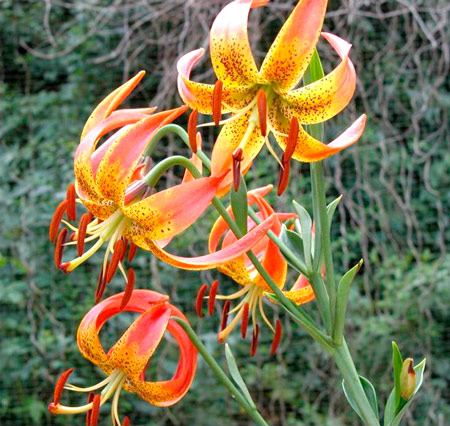Searching for the Carolina lily
By Ken Moore
Flora Columnist
Back in 1903, Dr. W. C. Coker, UNC professor of botany, began the Coker Arboretum as an outdoor classroom to supplement classes on identification and ecology of North Carolina native plants. Over at N.C. State University, botany professor Dr. B. W. Wells was actively defining the discipline of plant ecology and described the state’s plant communities for the general public in the classic The Natural Gardens of North Carolina, published in 1932.

More than a century ago, Cornelia Phillips Spencer painted Carolina lily in context with its plant community associates, blueberry and bracken fern. Photo of painting by Ken Moore
Well before them, however, Cornelia Phillips Spencer, who continuously pestered the state legislature between 1870 and 1875 to reopen the university following its closure during the Reconstruction, was already making ecological observations about plants growing in the environs of Chapel Hill.
For more than two decades, often accompanied by her daughter, Julia, and the two Mason girls, Varina and Martha, she explored the surrounding fields and forests. On these excursions, in all seasons, she collected “ecological bouquets†of wild and cultivated flowers, some of which remain to this day as lovely colored botanical illustrations by Mrs. Spencer and her daughter.
Studying each of these beautiful illustrations, one can view details of the plant community she observed. The flower portrait above features the Carolina or Mixhaux’s lily, Lilium michauxii, painted with its ecological associates, dryland blueberry, Vaccinium pallidum, and bracken fern, Pteridium aquilinum. Cornelia Spencer most likely encountered this grouping on the high bluffs above Morgan Creek, still called Laurel Hill.
More than a century following her painting, the Carolina lily was officially designated the State Wildflower by the N.C. General Assembly in 2003. Though commonly scattered in dry upland forests throughout the state, it is seldom seen. They only attract attention when in flower for a brief week or two in mid-summer. Frequent mowing along our highways eliminates the likelihood of spotting our State Wildflower.
During my years of botanizing, I’ve only seen this native lily a few times up on Occoneechee Mountain, along with its ecological companions, dryland blueberry and bracken fern.
Early last month while viewing the mountain’s fantastic mountain laurel display, I explored the area I know to contain the lilies. I was happy to find a couple of dozen plants. When I returned last week to catch them in flower, I could not find as many. But I did find a few, most with a single flower bud and a couple with two flower buds. Though Johnny Randall has photographed one at the N.C. Botanical Garden with several flowers, I’ve never seen more than a two-flowered plant in the wild.
I’m going back to try to catch it in flower and have fingers crossed that they’re not eaten by deer or picked by enthusiastic unsupervised children inclined to pick pretty flowers.
I’m going early on the Fourth of July. You’re most welcome to join me.
Join Ken Moore on his search for the Carolina lily on Occoneechee Mountain on July 4, beginning at 8:30 a.m. from visitor’s parking area at the end of Virginia Cates Road in Hillsborough.
Email Ken Moore at flora@carrborocitizen.com. Find previous Ken Moore Citizen columns at The Annotated Flora.



Comments are closed.